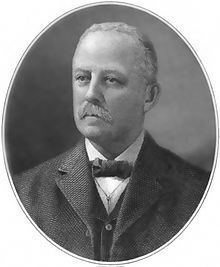Children William Atkinson Jones Preceded by Marlin Edgar Olmsted Name William Jones Succeeded by S. Otis Bland | Role U.S. representative Resigned April 17, 1918 Spouse(s) Claude Douglas Motley Books Maxims for Men-at-arms | |
 | ||
Born March 21, 1849Warsaw, Virginia ( 1849-03-21 ) Resting place St. John's Episcopal Church Cemetery37°57′28″N 76°45′19″W / 37.957901°N 76.755226°W / 37.957901; -76.755226 Died April 17, 1918, Washington, D.C., United States | ||
William Atkinson Jones (March 21, 1849 – April 17, 1918) was a member of the U.S. House of Representatives from 1891 to 1918 from the first district of the Commonwealth of Virginia.
Contents
Early life
Jones was born in Warsaw, Virginia on March 21, 1849 coming from honorable American stock. His great-grandfather, Joseph Jones, was a general in the Revolutionary War, an intimate and trusted friend of Lafayette, and subsequently postmaster of Petersburg, Virginia by appointment of Thomas Jefferson. Thomas Jones, the son of Joseph, married Mary Lee, the daughter of Richard Lee, long a member of the Virginia House of Burgesses from Westmoreland County, a first cousin of the famous Richard Henry Lee; and from this marriage was born Thomas Jones II, his father who married Anne Seymour Trowbridge of Plattsburg, New York. James Trowbridge, his maternal grandfather, was recognized by the Congress for his gallantry at the Battle of Plattsburg in 1814. He came from a good heritage, a heritage of which he never boasted, but which he exemplified by a life of high purpose and eminent usefulness.
Education
His boyhood fell during the American Civil War. His father, a former soldier, lawyer, and a judge entered him as a cadet at the Virginia Military Institute in Lexington in the fall of 1864, where he remained until the evacuation of Richmond, serving as occasion required with the corps of that famous institute in defense of the capital of his State. Thus, as a boy of 16 he did arduous and valiant military service. He was then placed in Coleman's School, at Fredericksburg from which he entered the University of Virginia at Charlottesville in October, 1868. He graduated with distinction in its School of Law in June, 1870. He was also a noted athlete in school.
He was admitted to the bar in 1870 and commenced practice in Warsaw, Virginia. He became a Commonwealth attorney for several years.
Politics
Jones became active in the Democratic Party politics and served as a delegate to the Democratic National Convention in 1880, 1896, and 1900. He was elected to thirteen consecutive Congresses beginning in 1891. From 1911 to 1918, he served as Chairman of the House Committee on Insular Affairs, which had jurisdiction over areas including the Philippines and Puerto Rico. He is best remembered as the House sponsor of the Jones Act or the Philippine Autonomy Act, which promised ultimate independence to the Philippines. He also sponsored the Jones-Shafroth Act, which modified the Organic Act of Puerto Rico and conferred United States citizenship on Puerto Ricans.
Family
William Atkinson Jones was married to Claude Douglas Motley (b. 1864) of James, Virginia on January 23, 1889 in Lynchburg County, Virginia. The couple had a son also named William Atkinson Jones born in Warsaw on September 16, 1889. He became a lawyer like his father and served in World Wars I & II.
Death
On April 7, 1918, Jones was attacked by paralysis and was taken to George Washington University Hospital in Washington, D.C.. He remained unconscious from the day of the attack till he died on April 17, 1918. He was buried at the graveyard of St. John's Episcopal Church in Warsaw on April 19. The monument on his grave was paid for by the citizens of the Philippines as a token of gratitude for his support of their independence by authoring the Philippine Autonomy Act enacted in 1916.
His personal and official papers were donated to the Special Collections Library of the University of Virginia and are open for research.
Memorials
Jones was well loved all over the Philippine archipelago for his work for the passage of the law that bears his name. A major bridge in Manila, Jones Bridge, was named after him. Construction of the bridge was started by the Americans in 1916 to replace the historical bridge, Puente de España (Bridge of Spain), one block upriver after it was destroyed by flood in 1914. At the time of Jones's death the new bridge, which was still under construction, was named in his honor. The Philippine Legislature had appropriated funds for the erection of a mausoleum over his tomb in Warsaw, his home town, and a monument in Manila.
The new municipality of Jones, Isabela was named in his honor when it was inaugurated in 1921. The municipality of Banton, Romblon was renamed as Jones in 1918 in his honor but reverted to its old name in 1959.
